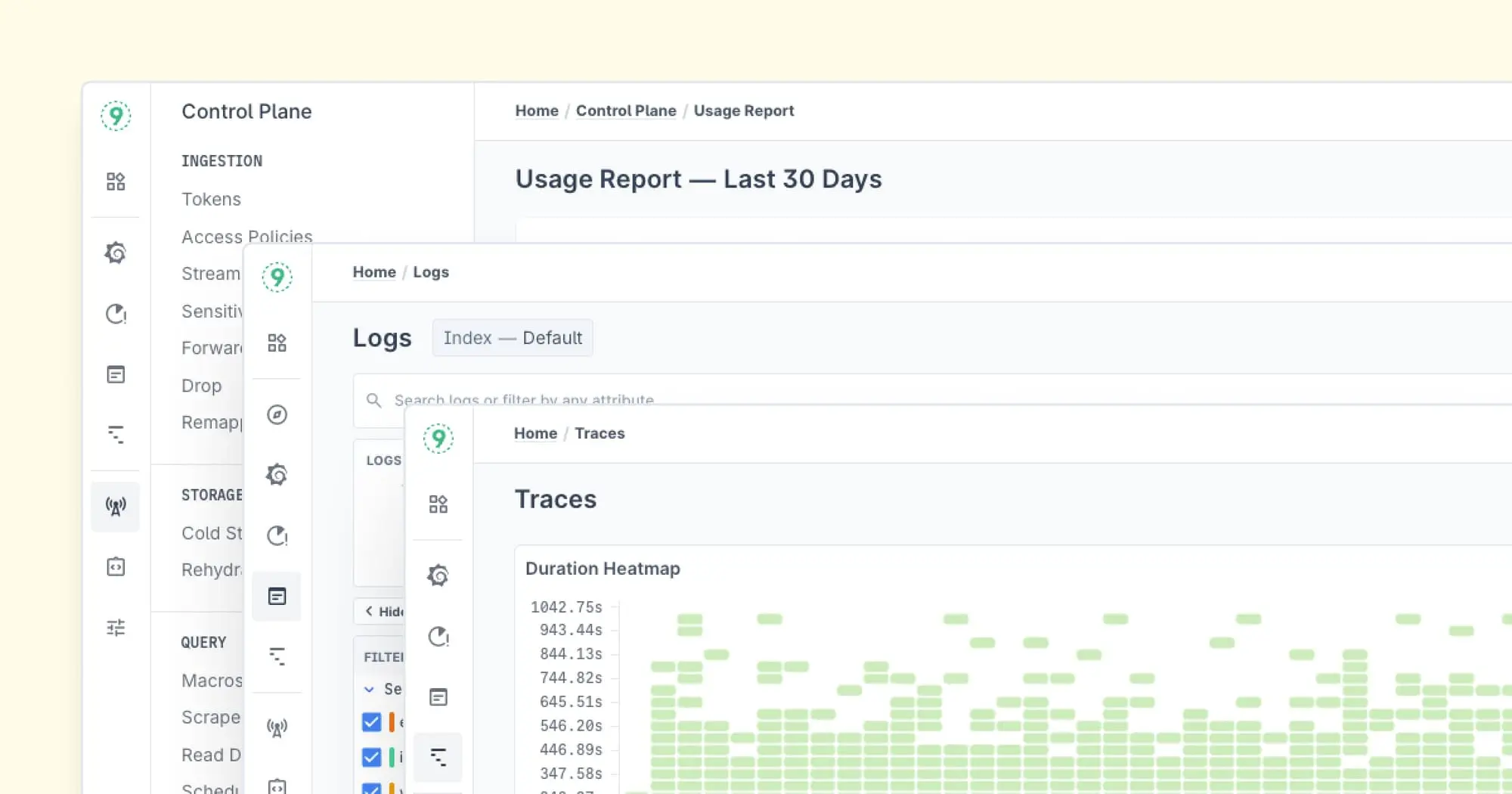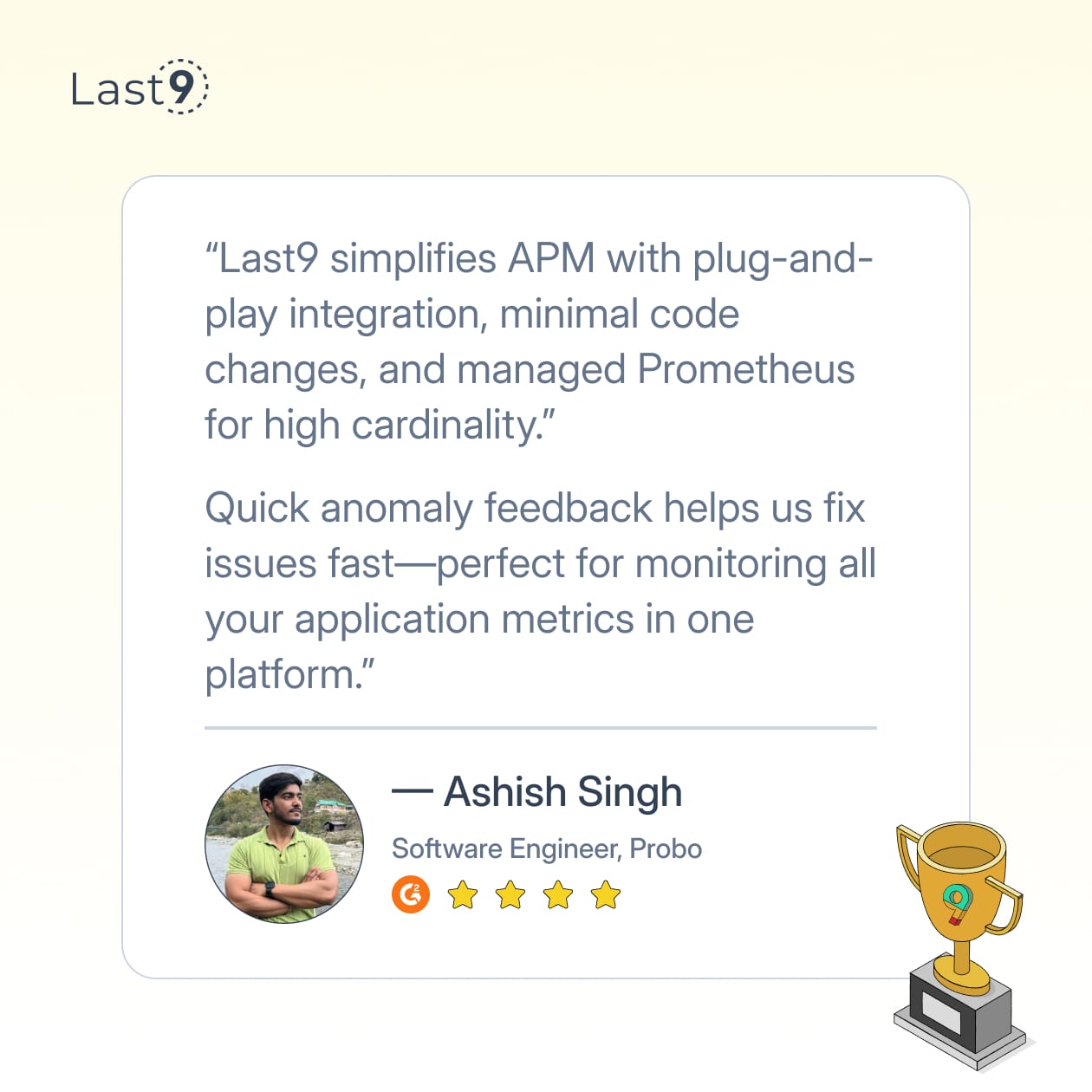Java remains a go-to language for building reliable, enterprise-grade applications. To keep things running smoothly, it's essential to monitor the performance of your Java applications. Monitoring helps ensure your app is performing at its best, offering a smooth user experience and avoiding unexpected downtime.
In this guide, we'll cover the basics of Java application monitoring, key metrics you should track, and the tools that can make the process easier and more insightful.
Why Monitor Java Applications?
Java applications often serve as critical components in production environments. If they experience poor performance, memory leaks, or unresponsive threads, it can impact users and systems across the board.
Monitoring your Java application helps you:
- Identify Performance Bottlenecks: Find issues like slow database queries, high CPU usage, or inefficient memory allocation.
- Enhance User Experience: Make sure your app is responsive and reliable, even under varying loads.
- Improve Troubleshooting: Catch issues early and resolve them before they escalate.
- Optimize Resource Usage: Ensure your app uses system resources, like CPU and memory, efficiently.
Key Metrics for Java Application Monitoring
When monitoring Java applications, focus on these essential metrics to gain useful insights:
1. Heap Memory Usage
Java uses heap memory to store objects while the application runs. Monitoring heap usage helps you spot memory leaks or ensure memory is allocated appropriately.
2. Garbage Collection (GC) Activity
If garbage collection (GC) runs too frequently or takes too long, it could be a sign of memory issues. By tracking GC activity, you can ensure the application is managing memory efficiently.
3. Thread Count and States
Monitoring thread activity (active, blocked, waiting) helps prevent issues like thread contention or deadlocks that could affect your app's performance.
4. CPU and Memory Usage
Keep an eye on your system's CPU and memory usage to prevent overutilization and keep performance stable.
5. Response Time and Latency
Measure how quickly your application processes requests, especially during peak load times. High response times or latency can harm the user experience.
6. Application Logs
Regularly analyze your logs for errors, exceptions, or warnings. Logs can provide vital clues when diagnosing underlying issues.
What is Code-Level Monitoring in Java?
Code-level monitoring focuses on digging deep into your Java application to identify performance issues and inefficiencies in the code itself. It’s like having a magnifying glass for your app, helping you find and fix problems at their root.
Here’s a breakdown of key aspects and how to approach them:
1. Tracing Function Calls
Monitoring how methods are invoked and executed is crucial for understanding where bottlenecks occur. Slow method calls, repeated database queries, or inefficient loops can degrade application performance.
How to do it:
- Use Application Performance Monitoring (APM) tools like Last9, AppDynamics, or Dynatrace to trace method-level execution.
- Annotate critical methods for detailed tracing with frameworks like OpenTelemetry.
2. Identifying Slow Queries
Database queries are often the culprit for performance issues. Slow or excessive queries can slow down your application, even if the code itself is running fine.
How to do it:
- Use query performance tools like Hibernate's built-in statistics, JPA query logging, or database-specific profilers.
- Use tools like p6spy to log SQL queries for analysis.
3. Analyzing Method Hotspots
Some methods are frequently executed or consume a disproportionate amount of resources, making them hotspots for optimization.
How to do it:
- Use profilers like YourKit, JProfiler, or Java Mission Control to analyze CPU and memory usage at the method level.
- Optimize code for frequently executed methods by reducing algorithm complexity or avoiding redundant computations.
4. Monitoring Exception Rates
High exception rates can point to unhandled edge cases, poor error handling, or deeper issues in the application logic.
How to do it:
- Configure logging frameworks like Log4j or SLF4J to capture exceptions with stack traces.
- Monitor exception patterns using tools like Sentry or Rollbar to identify recurring issues.
5. Tracking Resource Utilization
Monitor how efficiently your code uses resources like memory, threads, and CPU. Poor resource handling can lead to memory leaks, thread contention, or excessive garbage collection.
How to do it:
- Use heap dump analysis tools like Eclipse MAT to identify memory leaks.
- Track thread usage with thread dump analyzers and monitor CPU usage with tools like VisualVM or Java Flight Recorder.
6. Instrumentation for Custom Metrics
Custom metrics offer insights tailored to your application's unique behavior, such as processing time for specific business logic or the size of a message queue.
How to do it:
- Use libraries like Micrometer to define and expose custom metrics.
- Push these metrics to monitoring systems like Prometheus or Graphite for visualization.
7. Real-Time Code Insights
When issues occur in production, real-time insights into code behavior can help resolve problems quickly.
How to do it:
- Use tools like Rookout or Thundra to dynamically insert breakpoints and collect data from live applications without restarting.
- Combine real-time insights with logs, traces, and metrics for a complete picture.
Best Practices for Code-Level Monitoring
- Prioritize Key Components: Focus monitoring efforts on critical sections of the application, such as APIs, database interactions, and third-party integrations.
- Automate Alerts: Set up alerts for abnormal patterns like increased method latency or higher-than-usual error rates.
- Integrate Monitoring in CI/CD: Include monitoring hooks in your CI/CD pipelines to catch performance regressions early.
What is Java Virtual Machine (JVM) Monitoring
Java Virtual Machine (JVM) monitoring focuses on keeping tabs on the engine that powers Java applications.
The JVM is where all the magic (and sometimes the chaos) happens—managing memory, executing threads, and handling garbage collection.
Monitoring it ensures that your Java application runs efficiently and avoids performance hiccups.
1. Heap Memory Usage
The JVM allocates memory into different regions: Eden, Survivor, Old, and Permanent Generation (or Metaspace in newer JVM versions). Monitoring these regions helps identify memory leaks and inefficient allocation.
How to monitor:
- Track heap size and usage trends over time.
- Look for high usage in the Old Generation, which might signal memory retention issues.
- Use tools like VisualVM, JConsole, or Java Mission Control for real-time insights.
2. Garbage Collection (GC) Performance
Garbage collection clears unused objects from memory, but excessive GC activity can lead to high latency or stop-the-world pauses.
Key metrics to track:
- GC duration: Long pauses indicate issues.
- GC frequency: Frequent collections might signal memory pressure.
How to monitor:
- Enable GC logging (-Xlog:gc* in newer JVMs).
- Use GC analysis tools like GCViewer or GCEasy to interpret logs and identify tuning opportunities.
3. Thread Activity
JVM threads execute application logic, handle user requests, and perform background tasks. Monitoring thread activity helps prevent bottlenecks like deadlocks, thread contention, or thread pool exhaustion.
What to monitor:
- Active thread count.
- Threads in blocked or waiting states.
- Thread pool utilization in applications using executors.
How to monitor:
- Use thread dump analyzers like FastThread or Eclipse MAT to identify problematic threads.
- Tools like Java Flight Recorder can provide detailed thread activity reports.
4. Class Loading
The JVM dynamically loads classes as needed, but excessive class loading or unloading can degrade performance and waste resources.
Metrics to track:
- Total loaded classes.
- Classes unloaded over time.
- Metaspace memory usage (for modern JVMs).
How to monitor:
- Use JConsole or VisualVM to monitor class loading metrics.
- Tune Metaspace settings (-XX:MetaspaceSize and -XX:MaxMetaspaceSize) for better performance.
5. CPU Usage
The JVM’s CPU usage reflects how efficiently it executes your application. High CPU usage can indicate resource-intensive code or inefficient garbage collection.
How to monitor:
- Track overall and per-thread CPU usage.
- Look for “hot threads” consuming disproportionate CPU.
- Use tools like VisualVM, htop, or APM tools for real-time insights.
6. JVM Uptime and Restarts
Frequent restarts can signal stability issues or misconfigurations. Monitoring uptime ensures that the JVM remains stable and responsive.
How to monitor:
- Track JVM uptime as a basic health check.
- Analyze logs for crash reports or out-of-memory errors leading to restarts.
7. JVM Metrics Integration
Integrating JVM metrics into a centralized observability system provides a complete view of the application’s health.
How to do it:
- Export JVM metrics with tools like Micrometer, Prometheus JMX Exporter, or Grafana dashboards.
- Combine JVM metrics with application-specific metrics for holistic monitoring.

Best Practices for JVM Monitoring
- Set Baselines: Define normal behavior for JVM metrics based on historical data to detect anomalies.
- Optimize JVM Parameters: Fine-tune options like -Xms, -Xmx, and GC-related flags based on monitoring insights.
- Automate Alerts: Configure alerts for critical JVM metrics, such as high heap usage or excessive GC pause times.
Java Monitoring with AI
Integrating artificial intelligence (AI) into Java monitoring is like having a super-intelligent assistant analyzing your application's performance 24/7.
AI-powered monitoring goes beyond traditional tools, identifying root causes of issues and optimizing performance with minimal manual intervention.
Here's how AI enhances Java monitoring and what it brings to the table:
1. Automated Anomaly Detection
AI algorithms excel at detecting patterns and anomalies in real time. Instead of relying on static thresholds, they adapt to your application's behavior, flagging unusual spikes in latency, CPU usage, or error rates.
How it helps:
- Identifies subtle issues, like memory leaks or thread contention, before they escalate.
- Reduces false alarms by accounting for normal variations in performance metrics.
Example Tools:
- Last9, Datadog, and AIOps platforms.
2. Root Cause Analysis (RCA)
One of the standout features of AI in monitoring is its ability to pinpoint the root cause of complex issues. By analyzing logs, metrics, and traces together, AI can trace cascading failures back to their origin.
How it helps:
- Saves time by eliminating manual debugging.
- Highlights dependencies between services or components causing performance degradation.
Example Scenario:
- A sudden spike in latency might be traced back to a slow database query triggered by a specific API call.
3. Predictive Analytics
AI can predict future issues by analyzing historical data trends. Whether it’s forecasting resource exhaustion or identifying code paths likely to fail under certain conditions, predictive analytics helps teams stay ahead.
How it helps:
- Prevents outages by alerting teams to potential risks.
- Optimizes capacity planning, ensuring enough resources are available for expected loads.
Example Use Case:
- Predicting that a high volume of incoming traffic during peak hours will exhaust JVM memory limits.
4. Intelligent Performance Optimization
AI can recommend or even implement optimizations to improve Java application performance. This might include tuning JVM parameters, adjusting thread pools, or caching frequently accessed data.
How it helps:
- Removes guesswork from performance tuning.
- Adapts to changing workloads dynamically.
Example Tools:
- New Relic AI, OpsRamp, and advanced APM solutions.
5. Log Analysis with AI
Parsing through logs manually can be overwhelming, especially for large-scale applications. AI tools can sift through logs, identify patterns, and correlate errors with specific issues or code changes.
How it helps:
- Speeds up troubleshooting by highlighting the most relevant log entries.
- Offers actionable insights without requiring in-depth log parsing knowledge.
Example Tools:
- Splunk, ELK Stack with machine learning plugins.
6. Self-Healing Systems
AI can go beyond monitoring by enabling self-healing. It can automate responses to common issues, such as restarting services, scaling resources, or cleaning up memory leaks.
How it helps:
- Reduces downtime by fixing issues in real time.
- Frees up developers and operators to focus on more strategic tasks.
Example Scenario:
- If a thread pool gets exhausted, AI can dynamically allocate additional threads or throttle incoming requests.
7. Context-Aware Alerts
Traditional alerting often leads to "alert fatigue" with too many notifications, many of which might not require action. AI refines this process by providing context-aware alerts that prioritize critical issues.
How it helps:
- Ensures the team focuses on what matters most.
- Provides detailed insights into the cause and impact of alerts.
Best Practices for Using AI in Java Monitoring
- Start Small: Begin with a tool that integrates easily into your existing monitoring stack and gradually expands AI capabilities.
- Use AIOps: Combine AI-powered monitoring with automated incident response systems for maximum efficiency.
- Validate Insights: While AI is powerful, verify its recommendations and predictions, especially in critical systems.
Tools for Monitoring Java Applications
Monitoring Java applications is essential for maintaining optimal performance, detecting issues early, and ensuring smooth operation. Below is a detailed overview of some of the most powerful tools that simplify this process and help teams stay ahead of potential problems:
Prometheus with JMX Exporter
Prometheus, paired with the JMX (Java Management Extensions) Exporter, is an outstanding solution for monitoring Java applications. It allows the export of JVM metrics such as heap memory usage, garbage collection times, and thread counts into Prometheus for advanced visualization and alerting.
Features:
- Exports JVM metrics, custom metrics, and application data.
- Integrates seamlessly with Grafana for creating dashboards.
- Offers scalable, efficient storage and querying of time-series data.
How It Helps:
Prometheus allows teams to monitor Java application health over time, set alerts, and visualize trends that provide actionable insights.
Last9
Last9 offers a comprehensive observability solution, tailored for cloud-native applications, with features specifically designed for Java monitoring. It integrates smoothly with Prometheus and other monitoring tools, giving deep visibility into application performance in distributed environments.
Features:
- AI-powered advanced anomaly detection.
- Integration with OpenTelemetry and Prometheus for full-stack observability.
- Real-time monitoring and alerting for Java applications, even in complex environments.
How It Helps:
Last9 provides insights into JVM metrics and application performance, helping quickly troubleshoot issues in distributed systems. It’s ideal for teams working with microservices and cloud-native architectures.

New Relic
New Relic is known for its robust real-time monitoring features, with a special focus on Java applications. It offers transaction tracing, error tracking, and detailed JVM performance metrics, along with intuitive AI-driven insights that help identify performance issues swiftly.
Features:
- Deep transaction and performance tracing for Java applications.
- JVM memory usage tracking and garbage collection insights.
- Real-time performance monitoring, complemented by rich visualizations.
How It Helps:
New Relic helps teams pinpoint slow transactions, excessive memory usage, and problematic database queries, allowing for quick optimization of code and system performance.
AppDynamics
AppDynamics provides full-stack monitoring, giving detailed views of Java application performance, from the JVM to business transaction analysis. It also maps dependencies between application components, helping teams see how each part of the system influences performance.
Features:
- Detailed Java performance analytics, including JVM heap dumps and thread monitoring.
- End-to-end transaction tracing, visualizing how requests flow through the system.
- Real-time monitoring of application health and resource utilization.
How It Helps:
AppDynamics enables teams to detect performance issues early, providing granular insight to optimize resource allocation and improve overall application efficiency.
Elastic Stack (ELK)
The Elastic Stack, comprising Elasticsearch, Logstash, and Kibana, is a robust set of tools for log aggregation and visualization. When combined with Metricbeat and Jolokia, it delivers comprehensive JVM monitoring, application logs, and system health insights.
Features:
- Log aggregation and search capabilities using Elasticsearch.
- Real-time visualizations with Kibana.
- Metric collection through Metricbeat and Jolokia for detailed JVM performance tracking.
How It Helps:
Elastic Stack is ideal for monitoring and analyzing logs live, making it easier to detect performance issues, exceptions, or failures in Java applications, especially when paired with a solid logging strategy.
VisualVM
VisualVM is a free, lightweight tool perfect for developers who need to monitor and troubleshoot Java applications on the fly. It provides real-time insights into memory usage, CPU utilization, thread activity, and heap dumps.
Features:
- Real-time CPU and memory usage tracking.
- Heap dumps and garbage collection analysis.
- Thread activity and performance profiling.
How It Helps:
VisualVM is great for developers looking for a quick, in-depth view of JVM behavior. It helps diagnose memory leaks, thread issues, and performance bottlenecks without requiring complex infrastructure.
Last9 has been an amazing partner in making inroads on what a solid observability platform should be. – Akash Saxena, CTO, Disney+ Hotstar
Troubleshooting Java Monitoring Challenges
Monitoring Java applications can feel like trying to read a book while riding a rollercoaster—there’s always a lot going on, and things move fast. Developers often face several challenges when keeping tabs on Java applications.
Let’s break down some common hurdles and how to overcome them.
1. Garbage Collection (GC) Monitoring
Garbage collection (GC) is essential for keeping memory usage in check, but if it runs too often or takes too long, it can slow down your application.
Balancing memory allocation, understanding GC logs, and identifying performance bottlenecks can be tricky.
How to overcome it:
Use tools like VisualVM, JConsole, or GCViewer to analyze GC activity. Fine-tune JVM parameters like -Xms, -Xmx, and -XX:MaxGCPauseMillis to optimize garbage collection based on your app’s needs.
2. Thread Management
Java applications are often multithreaded, which can lead to issues such as deadlocks, thread contention, and resource starvation. Debugging these problems can feel like untangling a ball of yarn.
How to overcome it:
Use thread dump analyzers to identify problematic threads. Tools like Eclipse MAT or Java Mission Control can help visualize thread states and pinpoint bottlenecks.
3. Memory Leaks
Despite automatic memory management, Java apps are not immune to memory leaks. Improperly managed references can hold onto memory longer than necessary, causing out-of-memory errors.
How to overcome it:
Use profiling tools like YourKit, Eclipse Memory Analyzer, or JProfiler to find objects with unexpectedly long lifetimes. Make memory leak testing a part of your regular development routine.
4. Monitoring Distributed Systems
Modern Java applications often run in distributed environments like microservices or cloud-native systems. Monitoring metrics, logs, and traces across multiple instances or containers can quickly become overwhelming.
How to overcome it:
Use observability tools like Prometheus, Last9, OpenTelemetry, and Grafana to collect and visualize data across your distributed systems. Use correlation IDs to trace requests across services.
5. JVM Version Compatibility
Different versions of the JVM can behave differently, especially when it comes to performance optimizations or deprecated features. This creates challenges in maintaining consistent performance across environments.
How to overcome it:
Regularly update to the latest stable JVM versions, but test thoroughly in staging environments to ensure consistency and avoid surprises in production.
6. Log Management
Logs are invaluable for troubleshooting, but as applications scale, the sheer volume of logs can make finding the root cause of an issue feel like searching for a needle in a haystack.
How to overcome it:
Implement structured logging and centralize logs using tools like Last9, (Elasticsearch, Logstash, Kibana) or Fluentd. Use meaningful log levels and avoid unnecessary verbosity.
7. High Overhead from Monitoring Tools
Ironically, monitoring tools can sometimes introduce performance overhead, which can impact the very metrics they are measuring.
How to overcome it:
Choose lightweight monitoring tools or configure them to capture only essential metrics. Regularly review and adjust your instrumentation to avoid overloading your application with unnecessary monitoring overhead.
Conclusion
Monitoring Java applications is more than just about keeping things up and running. It’s about ensuring users have a smooth experience, while also optimizing resources and cutting down on troubleshooting time.
Start by exploring tools like Prometheus, Last9, or Elastic Stack, and take charge of your application’s performance today.
FAQs
What is Java application monitoring?
Java application monitoring involves tracking the performance, health, and resource usage of Java-based applications. It helps detect issues like memory leaks, high CPU usage, slow response times, and thread contention, ensuring your application runs efficiently in production.
Why is monitoring Java applications important?
Monitoring helps identify performance bottlenecks, improve user experience, optimize resource usage, and quickly troubleshoot issues before they escalate. It ensures that your Java application performs well under varying loads and delivers consistent service to users.
What are the key metrics to monitor in Java applications?
Important metrics include heap memory usage, garbage collection activity, thread count and states, CPU and memory usage, response time, and application logs. These metrics help identify potential problems like memory leaks, inefficient code, and slow queries.
How does JVM monitoring differ from application monitoring?
JVM monitoring focuses on the Java Virtual Machine that runs your application. It tracks things like memory usage, garbage collection, CPU consumption, and thread activity within the JVM. Application monitoring, on the other hand, covers the overall performance of your app, including the JVM and business logic.
What tools are commonly used for Java application monitoring?
Popular tools include Prometheus, Last9, VisualVM, JConsole, Last9, and New Relic. These tools provide insights into application and JVM performance, helping teams troubleshoot issues, optimize performance, and maintain uptime.
How can AI improve Java monitoring?
AI enhances Java monitoring by automating anomaly detection, providing root cause analysis, predicting future issues based on historical data, and optimizing performance. It helps reduce manual intervention and enables more proactive monitoring and faster issue resolution.
What are common challenges in monitoring Java applications?
Challenges include managing garbage collection, handling thread management, tracking memory leaks, monitoring distributed systems, ensuring JVM version compatibility, and dealing with large volumes of logs. Addressing these challenges requires the right tools and strategies.
How can I monitor database queries in Java applications?
You can use tools like Hibernate statistics, JPA query logging, or SQL profilers like p6spy. These help identify slow or excessive queries that may affect your application's performance.
What is code-level monitoring, and how does it help?
Code-level monitoring focuses on tracking method calls, query performance, and resource usage within your Java code. It helps identify bottlenecks, optimize frequently called methods, and monitor exception rates for more efficient troubleshooting.
What is the role of JVM metrics in monitoring?
JVM metrics help track key performance indicators like heap memory usage, garbage collection activity, thread states, and CPU usage. Monitoring these metrics ensures that the JVM is functioning optimally and supports the performance of the Java application running on it.
How can I prevent performance issues in Java applications?
Prevent performance issues by monitoring key metrics, optimizing resource allocation, analyzing thread activity, and fine-tuning JVM settings. Using profiling tools and automating alerts can also help identify and resolve issues before they impact users.



